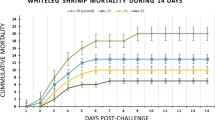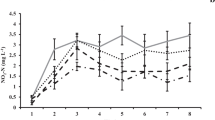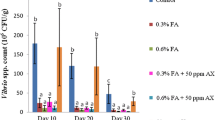Abstract
A 5-week feeding trial was conducted to evaluate the effects of biofloc in situ and commercial probiotic supplementation on white shrimp (1.87 ± 0.03 g) inorganic nitrogen control, growth, and immunophysiological response. For this purpose, four treatments were conducted: clear water with no probiotic application (CW), clear water with probiotic application (CW+P), biofloc with no probiotic application (FLOC), and biofloc with probiotic application (BFT+P); each group had three replicates. Growth parameters (final body weight, daily weight gain, specific growth rate) were significantly higher in the two biofloc systems (P < 0.05), and the FLOC and FLOC+P group did not have a significant difference (P > 0.05). The immune responses (total hemocyte count, complement component protein, and lysozyme) and antioxidant status (glutathione, catalase) in the CW+P, FLOC, and FLOC+P groups were increased significantly at the end of the experiment compared with the CW group (P < 0.05), and the FLOC and FLOC+P groups did not have a significant difference (P > 0.05). Results of a 10-day Vibrio harveyi challenge test show that the survival rates in CW+P, FLOC, and FLOC+P groups were significantly higher (P < 0.05), and the FLOC and FLOC+P groups did not have a significant difference (P > 0.05). These results suggest that probiotic addition in the biofloc system had little advantage, but probiotics can improve the immune status of the shrimp in the clear water system. Further, cost-effectiveness analysis showed that the biofloc system was an efficient and economical option for the production of white shrimp.



Similar content being viewed by others
References
Aguilera-Rivera D, Prieto-Davó A, Escalante K, Chávez C, Cuzon G, Gaxiola G (2014) Probiotic effect of FLOC on Vibrios in the pacific white shrimp Litopenaeus vannamei. Aquaculture 424–425:215–219
Alexander C, Sahu NP, Pal AK, Akhtar MS (2011) Haemato-immunological and stress responses of Labeo rohita (Hamilton) fingerlings: effect of rearing temperature and dietary gelatinized carbohydrate. J Anim Physiol Anim Nutr 95:653–663
Austin B, Zhang XH (2006) Vibrio harveyi: a significant pathogen of marine vertebrates and invertebrates. 43:119–124
Avnimelech Y (1999) Carbon/nitrogen ratio as a control element in aquaculture systems. Aquaculture 176:227–235
Avnimelech Y (2009) Biofloc technology. A practical guide book. The World Aquaculture Society, Baton Rouge
Avnimelech Y, Kochba M (2009) Evaluation of nitrogen uptake and excretion by tilapia in bio floc tanks, using 15N tracing. Aquaculture 287:163–168
Bachère E, Gueguen Y, Gonzalez M, De LJ, Garnier J, Romestand B (2004) Insights into the anti-microbial defense of marine invertebrates: the penaeid shrimps and the oyster Crassostrea gigas. Immunol Rev 198:149–168
Balcázar JL, Rojas-Luna T (2007) Inhibitory activity of probiotic Bacillus subtilis UTM 126 against Vibrio species confers protection against Vibriosis in juvenile shrimp (Litopenaeus vannamei). Curr Microbiol 55:409–412
Boshra H, Li J, Sunyer J (2006) Recent advances on the complement system of teleost fish. Fish Shellfish Immunol 20:239–262
Castex M, Lemaire P, Wabete N, Chim L (2009) Effect of dietary probiotic Pediococcus acidilactici on antioxidant defences and oxidative stress status of shrimp Litopenaeus stylirostris. Aquaculture 294:306–313
Castex M, Lemaire P, Wabete N, Chim L (2010) Effect of probiotic Pediococcus acidilactici on antioxidant defences and oxidative stress of Litopenaeus stylirostris under Vibrio nigripulchritudo challenge. Fish Shellfish Immunol 28:622–631
Dawood MA, Koshio S (2016) Recent advances in the role of probiotics and prebiotics in carp aquaculture: a review. Aquaculture 454:243–251
Ebeling JM, Timmons MB, Bisogni J (2006) Engineering analysis of the stoichiometry of photoautotrophic, autotrophic, and heterotrophic removal of ammonia–nitrogen in aquaculture systems. Aquaculture 257:346–358
Ekasari J, Rivandi DR, Firdausi AP, Surawidjaja EH, Jr MZ, Bossier P, Schryver PD (2015) Biofloc technology positively affects Nile tilapia (Oreochromis niloticus) larvae performance. Aquaculture 441:72–77
El-Dakar A, Goher T (2004) Using of Bacillus subtillus in microparticulate diets for producing biosecure of Peneaus japonicus postlarvae. Agric Sci Mansoura Univ 29:6855–6873
Engstad RE, Robertsen B, Frivold E (1992) Yeast glucan induces increase in lysozyme and complement-mediated haemolytic activity in Atlantic salmon blood. Fish Shellfish Immunol 2:287–297
Fast AW, Lester LJ (1992) Marine shrimp culture: principles and practices. Marine Shrimp Culture Principles & Practices
Furtado PS, Poersch LH, Jr WW (2011) Effect of calcium hydroxide, carbonate and sodium bicarbonate on water quality and zootechnical performance of shrimp Litopenaeus vannamei reared in bio-flocs technology (BFT) systems. Aquaculture 321:130–135
Gullian M, Thompson F, Rodriguez J (2004) Selection of probiotic bacteria and study of their immunostimulatory effect in Penaeus vannamei. Aquaculture 233:1–14
Hossain MI, Kamal MM, Mannan MA, Bhuyain MAB (2013) Effects of probiotics on growth and survival of shrimp (Penaeus monodon ) in coastal pond at Khulna, Bangladesh. J Sci Res 5:86–91
Hostins B, Lara G, Decamp O, Cesar DE, Wasielesky W (2017) Efficacy and variations in bacterial density in the gut of Litopenaeus vannamei reared in a BFT system and in clear water supplemented with a commercial probiotic mixture. Aquaculture 480:58–64
Irianto A, Austin B (2014) Probiotics in aquaculture. Drug Invent Today 5:55–59
Jin Y, Tian LX, Zeng SL, Xie SW, Yang HJ, Liang GY, Liu YJ (2013) Dietary lipid requirement on non-specific immune responses in juvenile grass carp (Ctenopharyngodon idella). Fish Shellfish Immunol 34:1202–1208
Jollow D, Mitchell J, Zampaglione N, Gillette J (1974) Bromobenzene-induced liver necrosis. Protective role of glutathione and evidence for 3, 4-bromobenzene oxide as the hepatotoxic metabolite. Pharmacology 11:151–169
Kim M-S, Min E, Kim J-H, Koo J-K, Kang J-C (2015) Growth performance and immunological and antioxidant status of Chinese shrimp, Fennerpenaeus chinensis reared in bio-floc culture system using probiotics. Fish Shellfish Immunol 47:141–146
Lin YC, Vaseeharan B, Ko CF, Chiou TT, Chen JC (2007) Molecular cloning and characterisation of a proteinase inhibitor, alpha 2-macroglobulin (α2-M) from the haemocytes of tiger shrimp Penaeus monodon. Mol Immunol 44:1065–1074
Lin S, Mao S, Guan Y, Lin X, Luo L (2012) Dietary administration of chitooligosaccharides to enhance growth, innate immune response and disease resistance of Trachinotus ovatus. Fish Shellfish Immunol 32:909–913
Long L, Yang J, Li Y, Guan C, Wu F (2015) Effect of biofloc technology on growth, digestive enzyme activity, hematology, and immune response of genetically improved farmed tilapia (Oreochromis niloticus). Aquaculture 448:135–141
Lygren B, Sveier H, Hjeltnes B, Waagbø R (1999) Examination of the immunomodulatory properties and the effect on disease resistance of dietary bovine lactoferrin and vitamin C fed to Atlantic salmon (Salmo salar) for a short-term period. Fish Shellfish Immunol 9:95–107
Ma H, Wang B, Zhang J, Li F, Xiang J (2010) Multiple forms of alpha-2 macroglobulin in shrimp Fenneropenaeus chinesis and their transcriptional response to WSSV or Vibrio pathogen infection. Dev Comp Immunol 34:677–684
Marklund S, Marklund G (1974) Involvement of the superoxide anion radical in the autoxidation of pyrogallol and a convenient assay for superoxide dismutase. FEBS J 47:469–474
Panigrahi A, Kiron V, Kobayashi T, Puangkaew J, Satoh S, Sugita H (2004) Immune responses in rainbow trout Oncorhynchus mykiss induced by a potential probiotic bacteria Lactobacillus rhamnosus JCM 1136. Vet Immunol Immunopathol 102:379–388
Rameshthangam P, Ramasamy P (2006) Antioxidant and membrane bound enzymes activity in WSSV-infected Penaeus monodon Fabricius. Aquaculture 254:32–39
Rattanachai A, Hirono I, Ohira T, Takahashi Y, Aoki T (2004) Molecular cloning and expression analysis of alpha 2-macroglobulin in the kuruma shrimp, Marsupenaeus japonicus. Fish Shellfish Immunol 16:599–611
Ray AJ, Seaborn G, Leffler JW, Wilde SB, Lawson A, Browdy CL (2011) Characterization of microbial communities in minimal-exchange, intensive aquaculture systems and the effects of suspended solids management. Aquaculture 310:130–138
Ringø E, Løvmo L, Kristiansen M, Bakken Y, Salinas I, Myklebust R, Olsen RE, Mayhew TM (2010) Lactic acid bacteria vs. pathogens in the gastrointestinal tract of fish: a review. Aquac Res 41:451–467
Rungrassamee W, Kingcha Y, Srimarut Y, Maibunkaew S, Karoonuthaisiri N, Visessanguan W (2014) Mannooligosaccharides from copra meal improves survival of the Pacific white shrimp (Litopenaeus vannamei) after exposure to Vibrio harveyi. Aquaculture 434:403–410
Saad AS, Habashy MM, Sharshar KM (2009) Growth response of the freshwater prawn, Macrobrachium rosenbergii (De Man), to diets having different levels of Biogen®. World Appl Sci J 6:550–556
Sakata T, Kojima T, Fujieda M, Miyakozawa M, Takahashi M, Ushida K (1999) Probiotic preparations dose-dependently increase net production rates of organic acids and decrease that of ammonia by pig cecal bacteria in batch culture. Dig Dis Sci 44:1485
Salahmesalhy A, Mohamedfathi M, George J (2008) Effect of probiotics on the survival, growth and challenge infection in Tilapia nilotica (Oreochromis niloticus). Aquac Res 39:647–656
Samocha TM, Patnaik S, Speed M, Ali AM, Burger JM, Almeida RV, Ayub Z, Harisanto M, Horowitz A, Brock DL (2007) Use of molasses as carbon source in limited discharge nursery and grow-out systems for Litopenaeus vannamei. Aquac Eng 36:184–191
Schveitzer R, Arantes R, Costódio PFS, do Espírito Santo CM, Arana LV, Seiffert WQ, Andreatta ER (2013) Effect of different biofloc levels on microbial activity, water quality and performance of Litopenaeus vannamei in a tank system operated with no water exchange. Aquac Eng 56:59–70
Shailesh S, Sahoo PK (2008) Lysozyme: an important defence molecule of fish innate immune system. Aquac Res 39:223–239
Talpur AD, Munir MB, Mary A, Hashim R (2014) Dietary probiotics and prebiotics improved food acceptability, growth performance, haematology and immunological parameters and disease resistance against Aeromonas hydrophila in snakehead (Channa striata) fingerlings. Aquaculture 426:14–20
Tao Y, Pan L, Zhang H, Tian S (2013) Assessment of the toxicity of organochlorine pesticide endosulfan in clams Ruditapes philippinarum. Ecotoxicol Environ Saf 93:22–30
Tavares-Sánchez OL, Gómez-Anduro GA, Felipe-Ortega X, Islas-Osuna MA, Sotelo-Mundo RR, Barillas-Mury C, Yepiz-Plascencia G (2004) Catalase from the white shrimp Penaeus (Litopenaeus) vannamei: molecular cloning and protein detection. Comp Biochem Physiol B Biochem Mol Biol 138:331–337
Truong Thy HT, Tri NN, Quy OM, Kannika K, Unajak S, Areechon N (2016) Effects of the dietary supplementation of mixed probiotic spores of Bacillus amyloliquefaciens 54A, and Bacillus pumilus 47B on growth, innate immunity and stress responses of striped catfish (Pangasianodon hypophthalmus). Fish Shellfish Immunol 60:391–399
Vazquez L, Alpuche J, Maldonado G, Agundis C, Pereyra-Morales A, Zenteno E (2009) Review: immunity mechanisms in crustaceans. Innate Immun 15:179–188
Verschuere L, Rombaut G, Sorgeloos P, Verstraete W (2000) Probiotic bacteria as biological control agents in aquaculture. Microbiology and molecular biology reviews 64:655–671
Wang C, Pan L, Zhang K, Xu W, Zhao D, Mei L (2016) Effects of different carbon sources addition on nutrition composition and extracellular enzymes activity of bioflocs, and digestive enzymes activity and growth performance of Litopenaeus vannamei in zero-exchange culture tanks. Aquac Res 47:3307–3318
Wasielesky W, Atwood H, Stokes A, Browdy C (2006) Effect of natural production in brown water super-intensive culture system for white shrimp Litopenaeus vannamei. Aquaculture 258:396–403
Xu W-J, Pan L-Q (2013) Enhancement of immune response and antioxidant status of Litopenaeus vannamei juvenile in biofloc-based culture tanks manipulating high C/N ratio of feed input. Aquaculture 412:117–124
Xu WJ, Pan LQ (2014) Evaluation of dietary protein level on selected parameters of immune and antioxidant systems, and growth performance of juvenile Litopenaeus vannamei reared in zero-water exchange biofloc-based culture tanks. Aquaculture 426–427:181–188
Xu WJ, Morris TC, Samocha TM (2015) Effects of C/N ratio on biofloc development, water quality, and performance of Litopenaeus vannamei juveniles in a biofloc-based, high-density, zero-exchange, outdoor tank system. Aquaculture 453:169–175
Yang SP, Wu ZH, Jian JC (2010) Effect of marine red yeast Rhodosporidium paludigenum on antioxidant-related gene expression in Litopenaeus vannamei. Isr J Aquacult Bamidgeh 65:247–261
Yeh ST, Liu CH, Chen JC (2004) Effect of ammonia on the immune response of white shrimp Litopenaeus vannamei and its susceptibility to Vibrio alginolyticus. Fish Shellfish Immunol 16:321–334
Zhang Q, Ma H, Mai K, Zhang W, Liufu Z, Xu W (2010) Interaction of dietary Bacillus subtilis and fructooligosaccharide on the growth performance, non-specific immunity of sea cucumber, Apostichopus japonicus. Fish Shellfish Immunol 29:204–211
Zhao P, Huang J, Wang XH, Song XL, Yang CH, Zhang XG, Wang GC (2012) The application of bioflocs technology in high-intensive, zero exchange farming systems of Marsupenaeus japonicus. Aquaculture 354–355:97–106
Zhou C, Ge X, Lin H, Niu J (2014) Effect of dietary carbohydrate on non-specific immune response, hepatic antioxidative abilities and disease resistance of juvenile golden pompano (Trachinotus ovatus). Fish Shellfish Immunol 41:183–190
Zhu Y, Thangamani S, Ho B, Ding JL (2005) The ancient origin of the complement system. EMBO J 24:382–394
Acknowledgements
This work was supported by the Key Program of Science and Technology of Zhejiang Province (Grant No. 2015C02010) and the Ministry of Science and Technology of China (Grant No. 2014BAD08B09).
Author information
Authors and Affiliations
Corresponding author
Rights and permissions
About this article
Cite this article
Liu, G., Ye, Z., Liu, D. et al. Inorganic nitrogen control, growth, and immunophysiological response of Litopenaeus vannamei (Boone, 1931) in a biofloc system and in clear water with or without commercial probiotic. Aquacult Int 26, 981–999 (2018). https://doi.org/10.1007/s10499-018-0263-1
Received:
Accepted:
Published:
Issue Date:
DOI: https://doi.org/10.1007/s10499-018-0263-1




